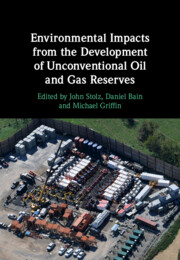Book contents
- Environmental Impacts from the Development of Unconventional Oil and Gas Reserves
- Environmental Impacts from the Development of Unconventional Oil and Gas Reserves
- Copyright page
- Contents
- Figures
- Tables
- Contributors
- Preface
- Part I Overview
- Part II Environmental Analysis
- 5 Air Quality
- 6 Methane and Climate Change
- 7 Water Usage and Management
- 8 Seismicity Induced by the Development of Unconventional Oil and Gas Resources
- 9 Naturally Occurring Radioactive Material (NORM)
- 10 Metal Isotope Signatures as Tracers for Unconventional Oil and Gas Fluids
- 11 Isotopes as Tracers of Atmospheric and Groundwater Methane Sources
- 12 The Microbiology of Shale Gas Extraction
- Part III Case Studies
- Index
- References
6 - Methane and Climate Change
from Part II - Environmental Analysis
Published online by Cambridge University Press: 28 July 2022
- Environmental Impacts from the Development of Unconventional Oil and Gas Reserves
- Environmental Impacts from the Development of Unconventional Oil and Gas Reserves
- Copyright page
- Contents
- Figures
- Tables
- Contributors
- Preface
- Part I Overview
- Part II Environmental Analysis
- 5 Air Quality
- 6 Methane and Climate Change
- 7 Water Usage and Management
- 8 Seismicity Induced by the Development of Unconventional Oil and Gas Resources
- 9 Naturally Occurring Radioactive Material (NORM)
- 10 Metal Isotope Signatures as Tracers for Unconventional Oil and Gas Fluids
- 11 Isotopes as Tracers of Atmospheric and Groundwater Methane Sources
- 12 The Microbiology of Shale Gas Extraction
- Part III Case Studies
- Index
- References
Summary
The first peer-reviewed analysis of how methane emissions affect the greenhouse gas footprint of shale gas was published by my colleagues and I in 2011. We suggested that methane emissions from shale gas, as well as from conventional natural gas, were probably great enough to completely offset any climate advantage that might accrue from reducing carbon dioxide emissions from a switch from coal to natural gas. The paper has stimulated further investigation in the subsequent nine years, with a growing number of research papers on this topic, as reviewed here. The initial conclusion that methane emissions from both shale gas and conventional natural gas make these very poor bridge fuels continues to hold true. The greenhouse gas footprint of shale gas is worse than that of coal, when methane emissions are considered and compared to carbon dioxide over an integrated 20-year time period after emission. Increased emissions from shale gas production in North America alone have probably caused roughly 40% of total global increase in atmospheric methane from all sources. Unless methane emissions can be drastically reduced, shale gas is not a viable option in a climate-smart future.
- Type
- Chapter
- Information
- Publisher: Cambridge University PressPrint publication year: 2022
References
- 2
- Cited by



